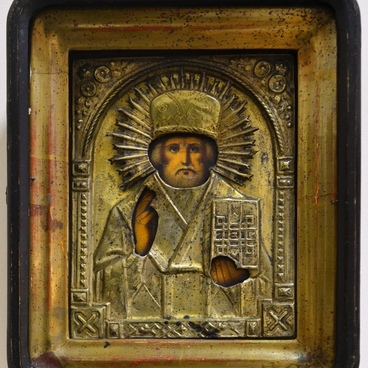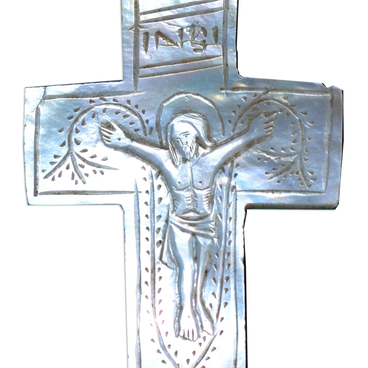Copper cast crosses of ‘Crucifixion of Christ’ became most widely spread during the18th century Orthodox schism into New Believers and Old Believers. Hiding from the persecution of the authorities, Old Believer masters had to move to the Pomor forests. People liked the Pomor craft.
«Crucifixion of Christ» Altar Cross
Creation period
18th century
Dimensions
19,5x37,5 cm
19.5х37.5х0.7 cm
19.5х37.5х0.7 cm
Technique
Cast copper alloy
Collection
Exhibition
4
Open in app#1
Unknown Author
‘Crucifixion of Christ’ Altar Cross
#5
#7
The ‘Crucifixion of Christ’ is a big altar cross made by an unknown Pomor master in the 18th century. Altar crosses were heavy crucifixes that were placed on the holy table (prestol) of the altar. Some crosses were as tall as 40 centimetres.
#3
The crucifix is decorated with an ornament which looks like pearls strung along the contour of the cross. It has chiselled edges, the reverse side is smooth ornamented with leaves, rosettes and grape vines. Such elements were used by Pomor masters to decorate crosses.
The central figure is crucified Jesus Christ who has four nails in his feet and palms. On either side he has the sun and the moon and there is God the Father - Lord Sabaoth - depicted above his head. The moon and the sun symbolise the heavenly host which included all celestial bodies and angels. The master uses these figures to convey the triumph of Jesus Christ in heaven after his earthly death.
The central figure is crucified Jesus Christ who has four nails in his feet and palms. On either side he has the sun and the moon and there is God the Father - Lord Sabaoth - depicted above his head. The moon and the sun symbolise the heavenly host which included all celestial bodies and angels. The master uses these figures to convey the triumph of Jesus Christ in heaven after his earthly death.
The angels on either side of God the Father hold pieces of towel cloth and the implements of Lord’s suffering — a lance and a staff. A wine vinegar-soaked sponge was put on a staff and given to Jesus to wet his lips to slake his thirst. A lance is what a Roman soldier pierced the Saviour in the side with to make sure that he had already died.
Jesus Christ is wearing a loin-cloth and is depicted dead – this version of the crucifix appeared only in the 10th century, before that the Saviour was depicted on the cross alive and triumphing.
Jesus Christ is wearing a loin-cloth and is depicted dead – this version of the crucifix appeared only in the 10th century, before that the Saviour was depicted on the cross alive and triumphing.
#2
Altar Cross “Crucifixion of Christ” (obverse and reverse sides)
#9
The eight-pointed cross as it was made by Pomor masters, apart from the main bar, had another two, the upper one and the slanted bottom one. The upper bar has a sign affixed to the cross with embossed lettering with the text in Russian from the Gospel, which means “Jesus of Nazareth, the King of the Jews”. It was believed that the slanted bar was there to weigh human sins. The upward-pointing edge points to those who repented and means absolution. The edge pointing downward, to the abyss of hell, indicates to the sinners what awaits them.
#10
Iskitim Municipal Museum of Arts and History
read morehide
00:00
00:00
1x
«Crucifixion of Christ» Altar Cross
Creation period
18th century
Dimensions
19,5x37,5 cm
19.5х37.5х0.7 cm
19.5х37.5х0.7 cm
Technique
Cast copper alloy
Collection
Exhibition
4
Open in app
Share

